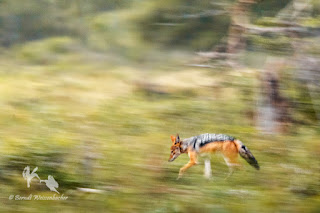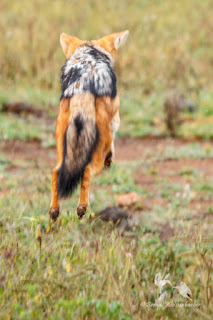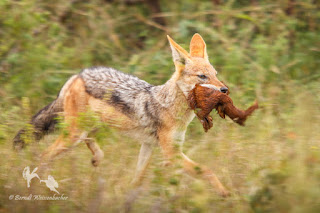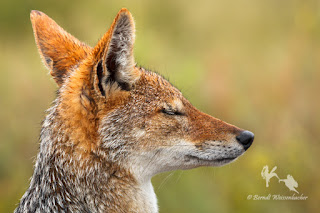ON PHOTOGRAPHY: Maximising the Odds of Photographic Expression – 1. Being a Black-backed Jackal
At the end of this year (2020), I will have
pursued my singular passion for photography for a full five decades. Although
my focus as an exclusively environmental photographer (as I call it) is very
narrow, I would like to regard myself as a serious photographer first, and then
as a crafter of images of the environment, its flora and its fauna.
My second great passion, which has compelled me
for almost as long as photography has, is the experience, exploration and
research of the interplay between organisms (especially animals) and their environment.
In my view of the natural world, individual beings fit into their species-specific
habitat much as a hand occupies a glove – except that in this instance the ‘glove’,
the environment, is immeasurably larger than the organism itself is. There is
also interaction and exchange of vital information and substances between the
organism and its environment. It is this sense of the embeddedness of
individuals within their habitat that I wish to explore and capture in images.
As a photographer, I consider myself as an explorer,
not of reality, but of light and shadow, line, shape and form, texture and
tone, pattern and rhythm, and of how these visual elements will contribute to
the expression of my intention in the final photograph. Most importantly, as a photographer
I am a surveyor of the Self, an explorer of my own, unique internal world of
the imagination.
Photography is a most demanding craft to master.
To capture the compositions and the quality of light in images that will complement
your projected visual communication always requires forethought, skill and hard
work; your success also depends greatly on chance if you work outdoors. Photography
becomes even more serendipitous when the subject is an organism (or many) that
can not be controlled. All photographers appreciate a second bite at the cherry
(as they say), or, at least, they would hope for an extended episode during
which they can explore several different compositions of the same setting, the identical
subject, to maximise the chances of capturing at least one exceptional image.
Such repetition of opportunity is especially rare when photographing fauna,
flora and the natural environment.
I search actively for images. I am not inclined
to sit in a hide for hours, waiting and hoping for the arrival of an organism
in a scene that I can not change. On foot or from a vehicle, I hunt for and
pounce on special light or a photogenic sighting of my intended prey. However,
when the prospect arises, two different, yet related circumstances afford me
the greatest opportunity to delight in, observe, mull over, explore and toil at
photography of the interplay between organisms and their habitat. Both situations,
if available to me, provide several separate chances for capturing images of a
particular subject. One approach, more difficult to seek out and to explore,
involves the repeated sighting of a particular individual or a group of animals
(the subjects). The alternative setting (which I will discuss in a follow-on
blog) involves travelling to and spending time repeatedly in the same small locality
(the place).
The intentions of animals are unknowable by
definition. At best, we may conclude from the current behaviour we witness what
action is likely (usually hopefully) to follow; at worst, the behaviour of
individuals or groups of animals is unpredictable. By spending some time in
their presence, on several separate occasions, I can at least observe a number
of episodes of behaviour. While not necessarily the same actions are ever
repeated, at least different encounters allow me to observe the animal or group
more attentively and to identify any patterns in the coming-and-going and their
manners. Thus I can familiarise myself slightly with the animals’ environmental
setting and their response to it. Their behaviour may remain unpredictable; at
least the likelihood of me bagging a splendid photograph becomes marginally more
probable.
Constantly I am on the lookout for burrows and
nests to which animals will return regularly. I may not intend to photograph
aspects of their reproductive behaviour, but I am a tad more confident that I
will be able to spy (not necessarily photograph) my intended prey. During the
heat of late mornings and early afternoons, waterholes or riverbanks will also
attract animals – not necessarily the same individuals, however. In addition, speaking
regularly to rangers or even tourists who have remained in an area for quite a
while is useful. Most often, such people possess a wealth of knowledge of the area
and its game, or, at least, they are wildlife enthusiasts and will share
willingly any information they have about the localities that will proffer my best
prospects of encountering certain species of animals. Even in the absence of
burrows, nests, waterholes and informants, I have had many opportunities of
spending some time in the company of particular individuals, getting several bites
at digital photography. (Hehe… I apologise!)
By now it is public knowledge that rain follows
me wherever I happen to go on photographic trips. One April several years ago,
Jacqui and I had splurged out to visit Tamboti Camp in the central region of
the Kruger National Park, South Africa. Predictably, the rain pelted or
drizzled down for more than a week – the light was less than ideal and
sightings that could be worked and photographed were rare.
Nevertheless, on our first morning drive, we
spotted a single Black-backed Jackal male running through a sizeable open area.
Upon our return from our first drive, a beautiful young female jackal had
joined the male. This pair entertained us with their antics most mornings and
most evenings, performed as a duo or singly. Knowing of their presence reduced the
need to pursue sightings and capture images of wildlife in the gloomy and wet
conditions. When the jackals decided to show themselves, we simply spent the
morning or evening in their presence; when the pair had gone into hiding or
were traipsing around further afield, Jacqui and I continued with an extended drive.
Not much happened; we did not get to see unique
or impressive jackal behaviour that week. Yet, being afforded the opportunity
to concentrate on capturing this pair of jackals, I managed to collect several
images – together they do reveal, at least, an inkling of what it takes to be a
Black-backed Jackal.









No comments:
Post a Comment